Estimated Grass Grazing Removal Rate in a Semiarid Eurasian Steppe Watershed as Influenced by Climate
Abstract
:1. Introduction
2. Materials and Methods
2.1. The Study Watershed
2.2. Data and Preprocessing
2.3. Description of the NPP-Prediction Model
2.4. Parameterization of the NPP-Prediction Model
2.5. Analysis of Grazing Removal Rate
3. Results
3.1. The Parameterized Model
3.2. The Estimated Removal Rate of Grasses
3.3. The Influences of Climate on Grazing Removal Rate of Grasses
4. Discussion
5. Conclusions
Acknowledgments
Author Contributions
Conflicts of Interest
References
- Henwood, W. The world’s temperate grasslands: A beleaguered biome. Parks 1998, 8, 1–2. [Google Scholar]
- Wang, Z. Strategic considerations for the protection of grassland ecosystems in China. Grassl. China 2005, 27, 1–2. (In Chinese) [Google Scholar]
- Barnes, R.F.; Nelson, C.J.; Collins, M.; Moore, K.J. Forages: An Introduction to Grassland Agriculture, 6th ed.; Iowa State Press: Ames, IA, USA, 2003; Volume 1. [Google Scholar]
- Chepil, W.S. Dynamics of wind erosion: V. cumulative intensity of soil drifting across eroding fields. Soil Sci. 1946, 61, 257. [Google Scholar] [CrossRef]
- Li, B.; Shi, P.J.; Lin, X.Q. Development of a Chinese grassland-livestock balance dynamic monitoring system. Grassl. Sci. 1995, 3, 95–102. [Google Scholar]
- White, R.P.; Murray, S.; Rohweder, M. Pilot Analysis of Global Ecosystems: Grassland Ecosystems; World Resource Institute: Washington, DC, USA, 2000. [Google Scholar]
- Intergovernmental Panel on Climate Change (IPCC). Climate Change 2001: The Scientific Basis; Contribution of Working Group 1 to Third Assessment Report of the IPCC (Chairs: J. Houghton and Y. Ding); Cambridge University Press: Cambridge, UK, 2001; p. 881. [Google Scholar]
- Peart, B. Lift in a Working Landscape: Towards a Conservation Strategy for the World’s Temperate Grasslands. In Proceedings of the Record of the World Temperate Grasslands Conservation Initiative Workshop, Hohhot, China, 28–29 June 2008.
- Li, S.; Asanuma, J.; Kotani, A.; Davaa, G.; Oyunbaatar, D. Evapotranspiration from a Mongolian steppe under grazing and its environmental constraints. J. Hydrol. 2007, 333, 133–143. [Google Scholar] [CrossRef]
- Jin, H.; Plaha, P.; Park, J.Y.; Hong, C.P.; Lee, I.S.; Yang, Z.H.; Jiang, G.B.; Kwak, S.S.; Liu, S.K.; Lee, J.S.; et al. Comparative EST profiles of leaf and root of Leymus chinensis, a xerophilous grass adapted to high pH sodic soil. Plant Sci. 2006, 170, 1081–1086. [Google Scholar] [CrossRef]
- Food and Agriculture Organization of the United Nations (FAO). Crop Evapotranspiration: Guidelines for Computing Crop Water Requirements. 2008. Available online: http://www.fao.org/docrep/x0490e/x0490e08.htm (accessed on 29 August 2014).
- McCarthy, D.F. Essentials of Soil Mechanics and Foundations, 6th ed.; Prentice Hall: Upper Saddle River, NJ, USA, 2002. [Google Scholar]
- Wang, X.; Li, F.; Gao, R.; Luo, Y.; Liu, T. Predicted NPP spatiotemporal variations in a semiarid steppe watershed for historical and trending climates. J. Arid Environ. 2014, 104, 67–79. [Google Scholar] [CrossRef]
- National Meteorological Information Center Website. Available online: http://www.nmic.gov.cn/web/index.htm (accessed on 6 August 2016).
- Luo, Y.; Wang, X.; Li, F.; Gao, R.; Duan, L.; Liu, T. Responses of grass production to precipitation in a mid-latitude typical steppe watershed. Trans. ASABE 2014, 57, 1595–1610. [Google Scholar]
- Zhang, X.; Srinivasan, R. GIS-based spatial precipitation estimation using next generation radar and raingauge data. Environ. Model. Softw. 2010, 25, 1781–1788. [Google Scholar] [CrossRef]
- Ortel, T.; Spies, R. NEXTRAD Quantitative Precipitation Estimates, Data Acquisition, and Processing for the DuPage County, Illinois, Streamflow-Simulation Modeling System; Fact Sheet 2015-3076; U.S. Department of the Interior and U.S. Geological Survey: Washington, DC, USA, 2015.
- FAO Website. Available online: http://www.iiasa.ac.at/Research/LUC/External-World-Soil-database/HTML (accessed on 6 August 2016).
- Saxton, K.E.; Rawls, W.J. Soil water characteristic estimates by texture and organic matter for hydrologic solutions. Soil Sci. Soc. Am. J. 2006, 70, 1569–1578. [Google Scholar] [CrossRef]
- U.S. Geological Survey (USGS). Land Processes Distributed Active Center (LPDAC) Website. Available online: https://lpdaac.usgs.gov/get_data/data_pool (accessed on 6 August 2016).
- Heinsch, F.A.; Reeves, M.; Votava, P.; Kang, S.; Milesi, C.; Zhao, M.; Glassy, J.; Jolly, W.M.; Loehman, R.; Bowker, C.F.; et al. User’s Guide: GPP and NPP (MOD17A2/A3) Products NASA MODIS Land Algorithm. 2003. Available online: http://www.ntsg.umt.edu/sites/ntsg.umt.edu/files/modis/MOD17UsersGuide.pdf (accessed on 30 June 2016).
- Guo, X.; He, Y.; Shen, Y.; Feng, D. Analysis of the terrestrial NPP based on the MODIS in the source regions of Yangtze and Yellow Rivers from 2000 to 2004. J. Glaciol. Geocryol. 2006, 28, 512–518. [Google Scholar]
- Yong, H.; Wenjie, D.; Xiaoyin, G. Terrestrial NPP variation in the region of the South-North Water Diversion Project (East Route). Adv. Clim. Chang. Res. 2006, 2, 246–249. [Google Scholar]
- He, Y.; Dong, W.; Guo, X.; Dan, L. Terrestrial growth in China and its relationship with climate based on the MODIS data. Acta Ecol. Sin. 2007, 27, 5086–5092. [Google Scholar] [CrossRef]
- Zhou, G.; Zhen, Y.; Chen, S.; Luo, T. NPP model of natural vegetation and its application in China. Sci. Silvae Sin. 1998, 34, 2–11. (In Chinese) [Google Scholar]
- Fu, B.P. On the calculation of the evaporation from land surface. Sci. Atmos. Sin. 1981, 5, 23–31. (In Chinese) [Google Scholar]
- Fu, B.P. On the calculation of evaporation from land surface in mountainous areas. Sci. Atmos. Sin. 1996, 16, 328–335. (In Chinese) [Google Scholar]
- Zhang, L.; Hickel, K.; Dawes, W.R. A rational function approach for estimating mean annual evaporation. Water Resour. Res. 2004, 40, W02502. [Google Scholar] [CrossRef]
- Budyko, M.I. The Heat Balance of the Earth’s Surface; National Weather Service, U.S. Department of Commerce: Washington, DC, USA, 1958.
- Yang, D.; Sun, F.; Liu, Z.; Cong, Z.; Ni, G.; Lei, Z. Analyzing spatial and temporal variability of annual water-energy balance in nonhumid regions of China using the Budyko hypothesis. Water Resour. Res. 2007, 43, W04426. [Google Scholar] [CrossRef]
- Yang, F.; Zhou, G. Characteristics and modeling of evapotranspiration over a temperate desert steppe in Inner Mongolia, China. J. Hydrol. 2011, 396, 139–147. [Google Scholar] [CrossRef]
- Istanbulluoglu, E.; Wang, T.; Wright, O.M.; Lenters, J.D. Interpretation of hydrologic trends from a water balance perspective: The role of groundwater storage in the Budyko hypothesis. Water Resour. Res. 2012, 48, W00H16. [Google Scholar] [CrossRef]
- Hou, Q.; Wang, Y.; Yang, Z.; Shi, G. Dynamic simulation and definition of crop coefficient for typical steppe in Inner Mongolia, China. Chin. J. Plant Ecol. 2010, 34. [Google Scholar] [CrossRef]
- Wang, X.; Yang, X.; Liu, T.; Li, F.; Gao, R.; Duan, L. Trend and extreme occurrence of precipitation in a mid-latitude Eurasian steppe watershed at various time scales. Hydrol. Process. 2013. [Google Scholar] [CrossRef]
- Viessman, W. Introduction to Hydrology, 5th ed.; Prentice Hall: Upper Saddle River, NJ, USA, 2002. [Google Scholar]
- Zhang, L.; Dawes, W.R.; Walker, G.R. Response of mean annual evapotranspiration to vegetation changes at catchment scale. Water Resour. Res. 2001, 37, 701–708. [Google Scholar] [CrossRef]
- Monteith, J.L. Evaporation and environment. In State and Movement of Water in Living Organisms, Proceedings of the 19th Symposium of the Society of Experimental Biology, New York, NY, USA, 10–15 July 1965; Cambridge University Press: Cambridge, UK, 1965; pp. 205–234. [Google Scholar]
- Douglas, E.M.; Jacobs, J.M.; Sumner, D.V.; Ray, R.L. A comparison of models for estimating potential evapotranspiration for Florida land cover types. J. Hydrol. 2009, 373, 366–376. [Google Scholar] [CrossRef]
- Tukimat, N.N.A.; Harun, S.; Shahid, S. Comparison of different methods in estimating potential evapotranspiration at Muda Irrigation Scheme of Malaysia. J. Agric. Rural Dev. Trop. Subtrop. 2012, 113, 77–85. [Google Scholar]
- Munson, B.R.; Okiishi, T.H.; Huebsch, W.W.; Rothmayer, A.P. Fundamentals of Fluid Mechanics; John Wiley & Sons, Inc.: Hoboken, NJ, USA, 2012. [Google Scholar]
- Brutsaert, W. Hydrology: An Introduction; Cambridge University Press: West Nyack, NY, USA, 2005. [Google Scholar]
- Wang, X.; Liu, T.; Li, F.; Gao, R.; Yang, X.; Duan, L.; Luo, Y.; Li, R. Simulated soil erosion from a semiarid typical steppe watershed using an integrated aeolian and fluvial prediction model. Hydrol. Process. 2014, 28, 325–340. [Google Scholar] [CrossRef]
- Irmak, S.; Irmak, A.; Jones, J.W.; Howell, T.A.; Jacobs, J.M.; Allen, R.G.; Hoogenboom, G. Predicting daily net radiation using minimum climatological data. J. Irrig. Drain. Eng. 2003, 129, 256–269. [Google Scholar] [CrossRef]
- Van Genuchten, M.T. A closed-form equation for predicting the hydraulic conductivity of unsaturated soils. Soil Sci. Soc. Am. J. 1980, 44, 892–898. [Google Scholar] [CrossRef]
- Ghanbarian-Alavijeh, B.; Liaghat, A.; Huang, G.; van Genuchten, M.T. Estimation of the van Genuchten soil water retention properties from soil textural data. Pedoshere 2010, 20, 456–465. [Google Scholar] [CrossRef]
- Saxton, K.E.; Rawls, W.J.; Romberger, J.S.; Papendick, R.I. Estimating generalizaed soil-water characteristics from texture. Trans. ASAE 1986, 50, 1031–1035. [Google Scholar]
- Allen, R.G.; Pereira, L.S.; Smith, M.; Raes, D.; Wright, J.L. FAO-56 Dual Crop Coefficient method for estimating evaporation from soil and application extensions. J. Irrig. Drain. Eng. 2005, 131, 2–13. [Google Scholar] [CrossRef]
- Liu, Y.; Luo, Y. A consolidated evaluation of the FAO-56 dual crop coefficient approach using the lysimeter data in the North China Plain. Agric. Water Manag. 2010, 97, 31–40. [Google Scholar] [CrossRef]
- Li, L.; Liu, X.; Chen, Z. Study on the carbon cycle of Leymus Chinensis steppe in the Xilin River Basin. Acta Bot. Sin. 1998, 40, 955–961. [Google Scholar]
- Schönbach, P.; Wan, H.; Gierus, M.; Bai, Y.; Müller, K.; Lin, L.; Susenbeth, A.; Taube, F. Grassland responses to grazing: Effects of grazing intensity and management system in an Inner Mongolian steppe ecosystem. Plant Soil 2011, 340, 103–115. [Google Scholar] [CrossRef]
- Ren, H.; Schönbach, P.; Wan, H.; Gienus, M.; Taube, F. Effects of grazing intensity and environmental factors on species composition and diversity in typical steppe of Inner Mongolia, China. PLoS ONE 2012, 7, e52180. [Google Scholar] [CrossRef] [PubMed]
- Yan, L.; Zhou, G.; Zhang, F. Effects of different grazing intensities on grassland production in China: A meta-analysis. PLoS ONE 2013, 8, e81466. [Google Scholar] [CrossRef] [PubMed]
- Leriche, H.; LeRoux, X.; Gignoux, J.; Tuzet, A.; Fritz, H.; Abbadie, L.; Loreau, M. Which functional processes control the short-term effect of grazing on net primary production in grasslands? Oecologia 2001, 129, 114–124. [Google Scholar]
- Neter, J.; Kutner, M.H.; Nachtsheim, C.J.; Wasserman, W. Applied Linear Statistical Models, 4th ed.; McGraw-Hill Companies, Inc.: New York, NY, USA, 1996. [Google Scholar]
- Zhou, G.; Wang, Y.; Wang, S. Responses of grassland ecosystems to precipitation and land use along the northeast China transect. J. Veg. Sci. 2002, 13, 361–368. [Google Scholar] [CrossRef]
- Hao, Y.; Wang, Y.; Mei, X.; Huang, X.; Cui, X.; Zhou, X.; Niu, H. CO2, H2O and energy exchange of an Inner Mongolia steppe ecosystem during a dry and wet year. Acta Oecol. 2008, 33, 133–143. [Google Scholar] [CrossRef]
- Haberl, H.; Erb, K.H.; Krausmann, F.; Gaube, V.; Bondeau, A.; Plutzar, C.; Gingrich, S.; Lucht, W.; Fischer-Kowalski, M. Quantifying and mapping the human appropriation of net primary production in earth’s terrestrial ecosystems. Proc. Natl. Acad. Sci. USA 2007, 104, 12942–12947. [Google Scholar] [CrossRef] [PubMed]
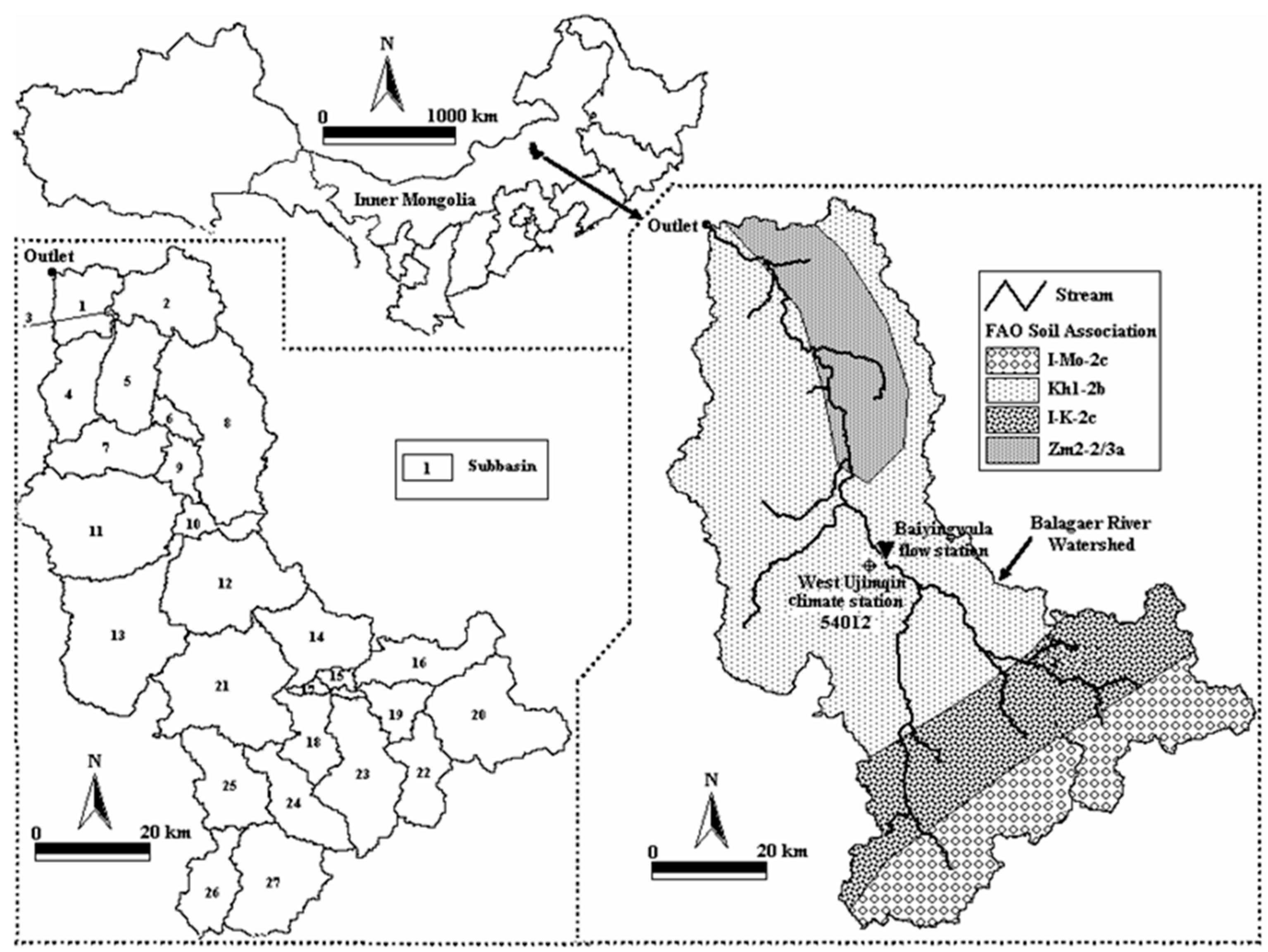
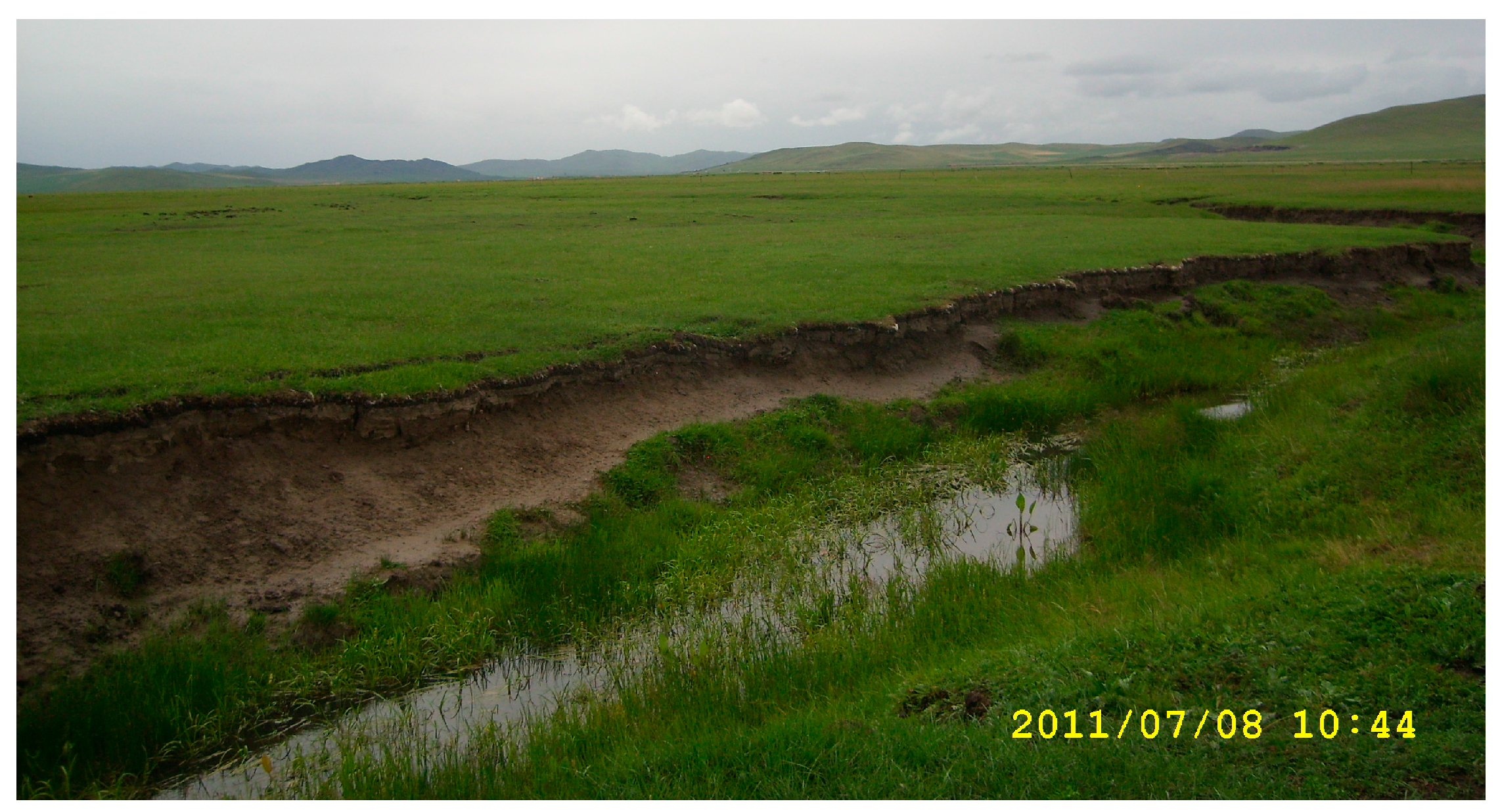
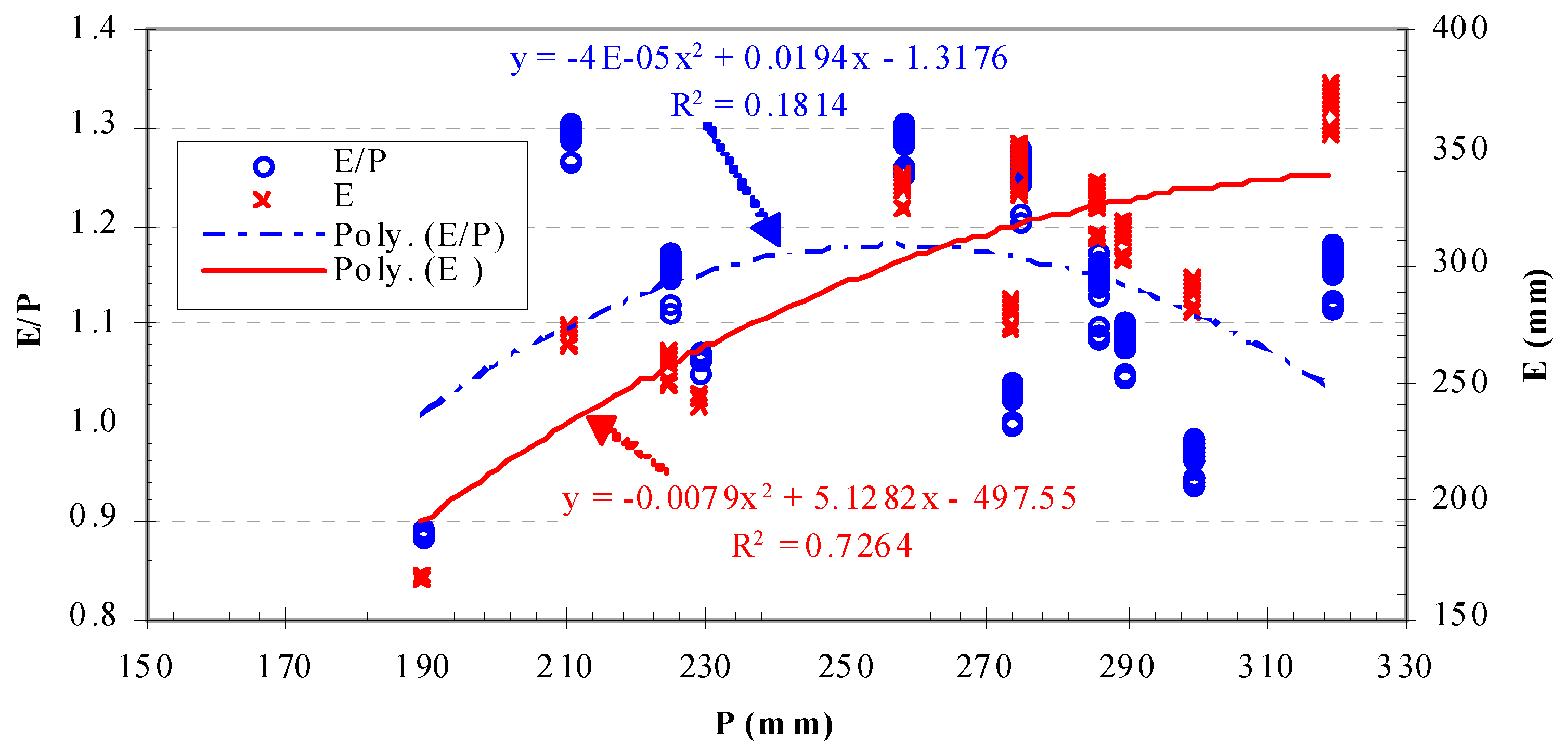

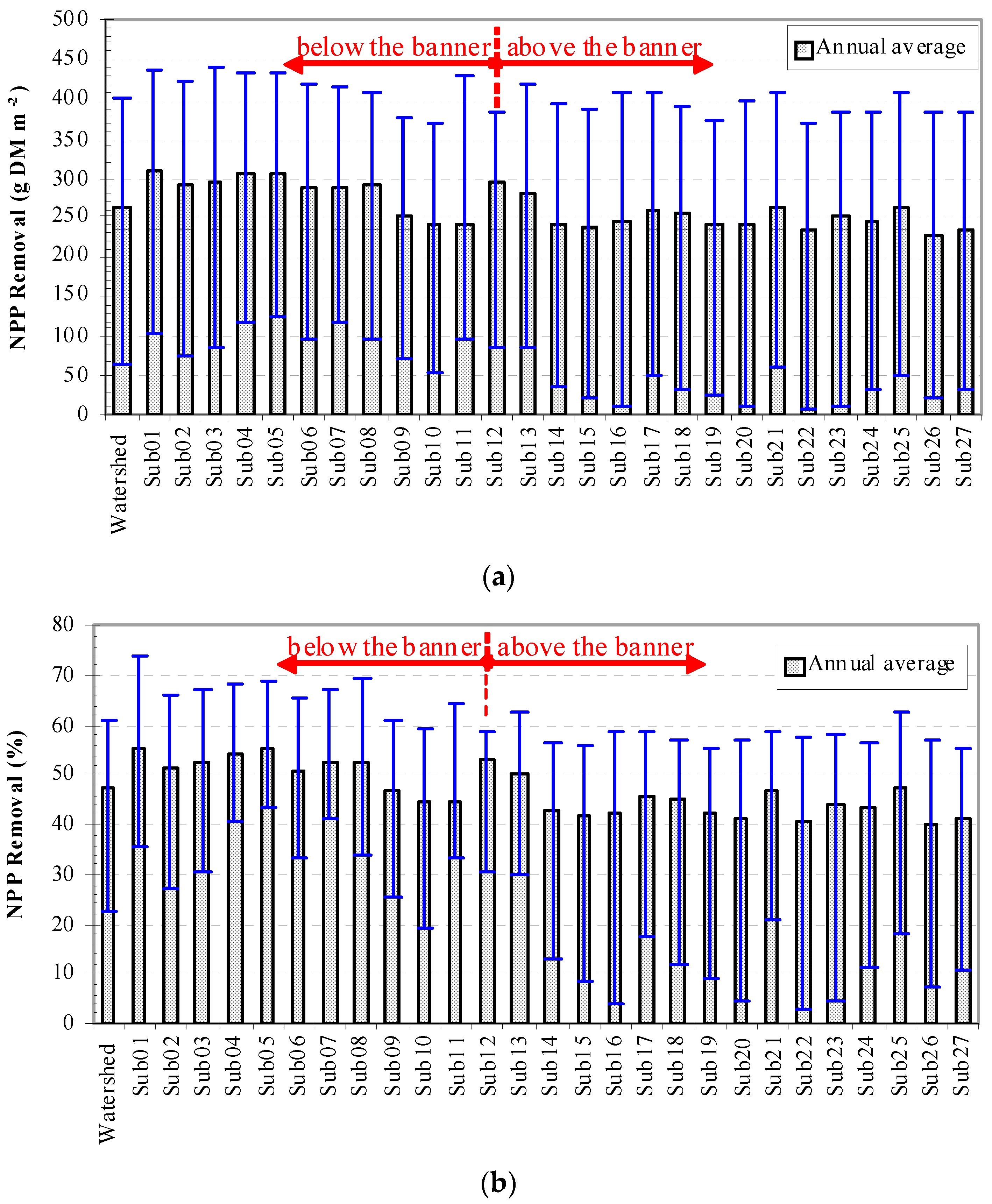
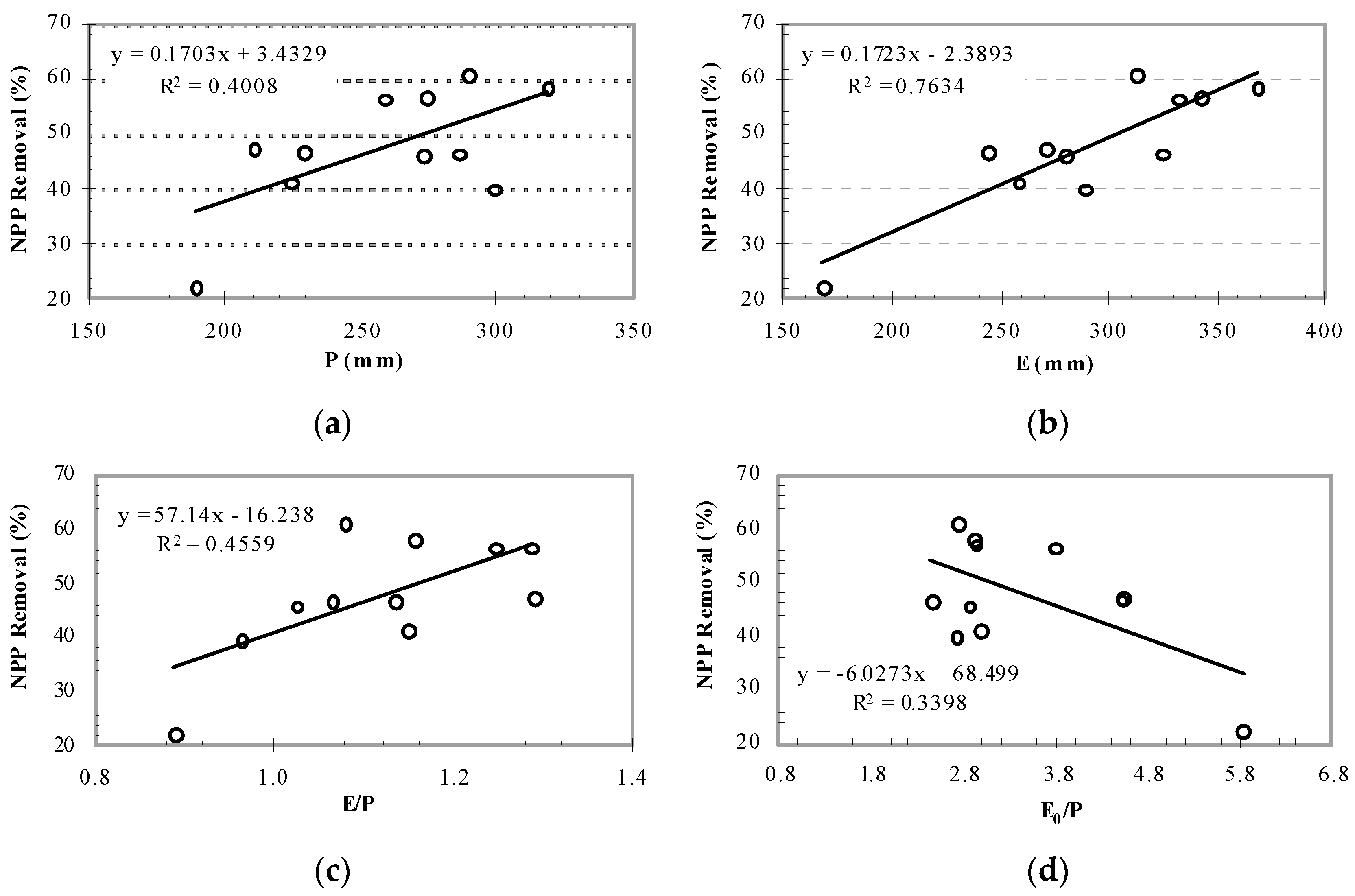
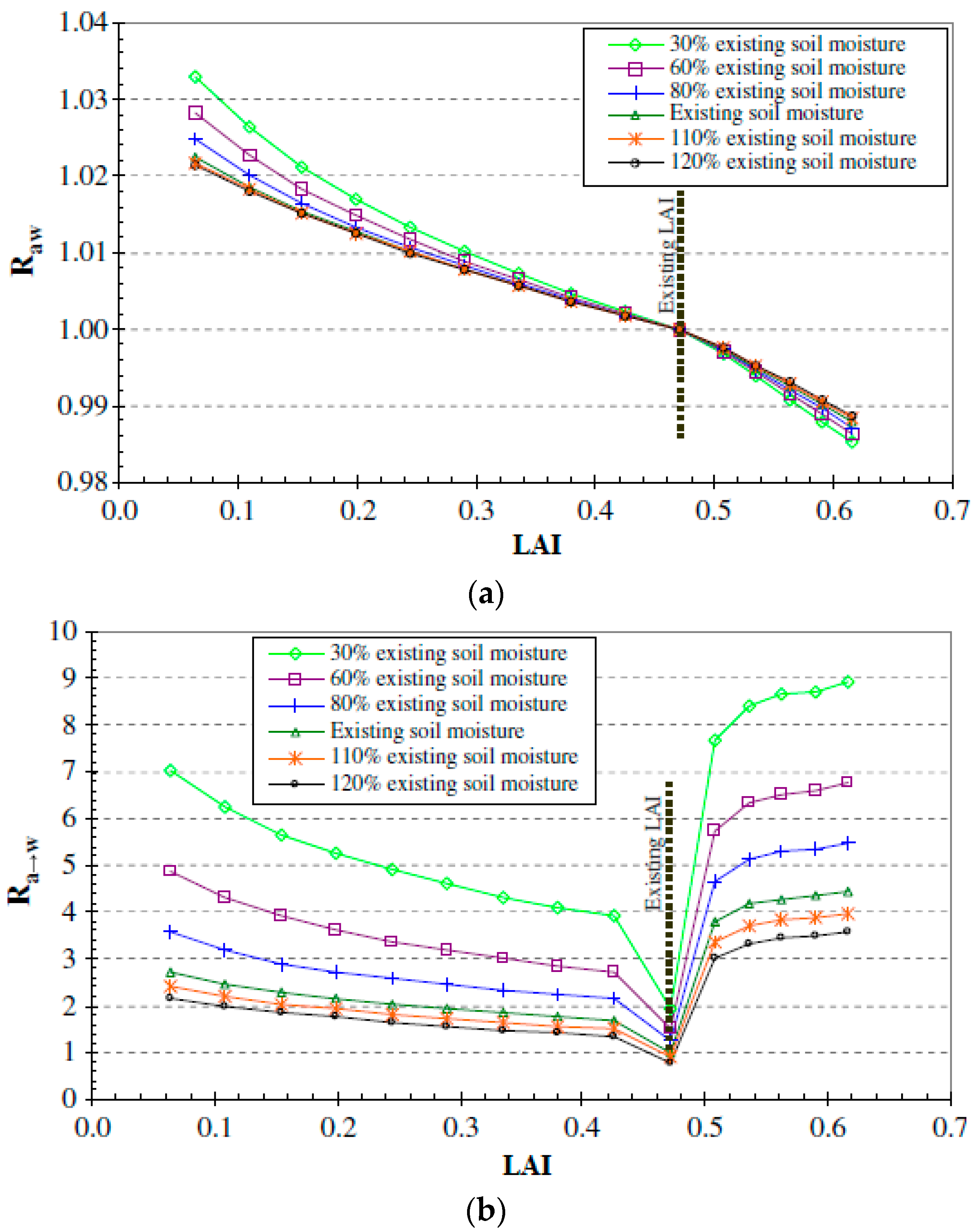
| Subbasin ‡ | Area (km2) | β (°) | ψ | θfc | θsat | Ks (mm·h−1) | ω |
|---|---|---|---|---|---|---|---|
| 1 | 140 | 3.36 | 0.155 | 0.323 | 0.481 | 11.33 | 3.901 |
| 2 | 222 | 2.87 | 0.155 | 0.323 | 0.481 | 11.33 | 3.955 |
| 3 | 3 | 1.29 | 0.137 | 0.317 | 0.480 | 12.59 | 4.144 |
| 4 | 163 | 3.45 | 0.237 | 0.392 | 0.514 | 4.64 | 4.381 |
| 5 | 195 | 2.65 | 0.164 | 0.320 | 0.473 | 9.75 | 4.022 |
| 6 | 40 | 1.54 | 0.156 | 0.311 | 0.471 | 11.31 | 4.072 |
| 7 | 172 | 2.70 | 0.103 | 0.232 | 0.458 | 34.18 | 3.385 |
| 8 | 453 | 2.58 | 0.103 | 0.232 | 0.458 | 34.18 | 3.394 |
| 9 | 67 | 1.89 | 0.050 | 0.104 | 0.462 | 107.48 | 2.908 |
| 10 | 66 | 2.68 | 0.051 | 0.120 | 0.460 | 96.74 | 2.961 |
| 11 | 458 | 2.30 | 0.131 | 0.286 | 0.465 | 15.75 | 3.812 |
| 12 | 351 | 4.04 | 0.050 | 0.107 | 0.461 | 105.30 | 2.876 |
| 13 | 455 | 3.39 | 0.126 | 0.270 | 0.460 | 18.24 | 3.608 |
| 14 | 211 | 3.39 | 0.140 | 0.295 | 0.467 | 13.86 | 3.762 |
| 15 | 23 | 2.64 | 0.140 | 0.295 | 0.467 | 13.86 | 3.839 |
| 16 | 169 | 6.46 | 0.237 | 0.382 | 0.504 | 4.64 | 3.941 |
| 17 | 23 | 2.89 | 0.113 | 0.283 | 0.469 | 18.80 | 3.722 |
| 18 | 127 | 3.27 | 0.113 | 0.283 | 0.469 | 18.80 | 3.686 |
| 19 | 91 | 4.68 | 0.123 | 0.280 | 0.465 | 17.70 | 3.558 |
| 20 | 323 | 6.98 | 0.315 | 0.433 | 0.514 | 1.27 | 4.552 |
| 21 | 419 | 4.42 | 0.159 | 0.304 | 0.464 | 11.16 | 3.725 |
| 22 | 148 | 6.55 | 0.159 | 0.304 | 0.464 | 11.16 | 3.536 |
| 23 | 243 | 5.18 | 0.159 | 0.304 | 0.464 | 11.16 | 3.654 |
| 24 | 174 | 5.22 | 0.159 | 0.304 | 0.464 | 11.16 | 3.650 |
| 25 | 201 | 4.54 | 0.159 | 0.304 | 0.464 | 11.16 | 3.714 |
| 26 | 141 | 8.67 | 0.159 | 0.304 | 0.464 | 11.16 | 3.376 |
| 27 | 270 | 7.19 | 0.159 | 0.304 | 0.464 | 11.16 | 3.485 |
| Watershed | 5350 | 4.17 | 0.149 | 0.287 | 0.470 | 22.69 | 3.443 |
| Year | Maximums | Minimums | ||||||
|---|---|---|---|---|---|---|---|---|
| MODIS-NPP | Model-NPP | Absolute | Percent | MODIS-NPP | Model-NPP | Absolute | Percent | |
| 2000 | Sub15 | Sub20 | Sub01 | Sub01 | Sub01 | Sub12 | Sub22 | Sub15 |
| 2001 | Sub15 | Sub20 | Sub01 | Sub01 | Sub01 | Sub12 | Sub15 | Sub15 |
| 2002 | Sub20 | Sub20 | Sub01 | Sub01 | Sub01 | Sub12 | Sub20 | Sub20 |
| 2003 | Sub26 | Sub20 | Sub04 | Sub05 | Sub08 | Sub12 | Sub26 | Sub26 |
| 2004 | Sub26 | Sub20 | Sub03 | Sub03 | Sub03 | Sub12 | Sub26 | Sub26 |
| 2005 | Sub15 | Sub20 | Sub04 | Sub04 | Sub04 | Sub12 | Sub15 | Sub15 |
| 2006 | Sub20 | Sub20 | Sub02 | Sub02 | Sub02 | Sub12 | Sub26 | Sub26 |
| 2007 | Sub22 | Sub20 | Sub05 | Sub05 | Sub05 | Sub12 | Sub22 | Sub22 |
| 2008 | Sub22 | Sub20 | Sub05 | Sub01 | Sub01 | Sub12 | Sub10 | Sub22 |
| 2009 | Sub26 | Sub20 | Sub07 | Sub07 | Sub07 | Sub12 | Sub26 | Sub26 |
| 2010 | Sub14 | Sub20 | Sub01 | Sub08 | Sub08 | Sub12 | Sub14 | Sub14 |
| Subbasin † | Pearson Correlation Coefficient between NPP Removal Rate (g DM m−2) and | Pearson Correlation Coefficient between NPP Removal Rate (%) and | ||||||
|---|---|---|---|---|---|---|---|---|
| P | E | E/P | E0/P | P | E | E/P | E0/P | |
| US 1 | 0.74 | 0.96 | 0.65 | −0.64 | 0.63 | 0.87 | 0.68 | −0.58 |
| 2 | 0.72 | 0.92 | 0.62 | −0.64 | 0.52 | 0.71 | 0.55 | −0.48 |
| 3 | 0.71 | 0.94 | 0.69 | −0.62 | 0.55 | 0.82 | 0.72 | −0.51 |
| 4 | 0.71 | 0.94 | 0.69 | −0.62 | 0.55 | 0.82 | 0.72 | −0.51 |
| 5 | 0.69 | 0.93 | 0.70 | −0.60 | 0.50 | 0.78 | 0.71 | −0.44 |
| 6 | 0.72 | 0.93 | 0.65 | −0.59 | 0.42 | 0.65 | 0.55 | −0.27 |
| 7 | 0.74 | 0.94 | 0.64 | −0.61 | 0.59 | 0.80 | 0.61 | −0.45 |
| 8 | 0.72 | 0.90 | 0.56 | −0.55 | 0.42 | 0.56 | 0.38 | −0.20 |
| 9 | 0.71 | 0.93 | 0.63 | −0.60 | 0.53 | 0.76 | 0.60 | −0.43 |
| 10 | 0.71 | 0.93 | 0.61 | −0.57 | 0.57 | 0.80 | 0.60 | −0.44 |
| 11 | 0.74 | 0.96 | 0.60 | −0.64 | 0.67 | 0.90 | 0.63 | −0.62 |
| 12 | 0.75 | 0.95 | 0.64 | −0.62 | 0.56 | 0.77 | 0.60 | −0.43 |
| DS 13 | 0.71 | 0.94 | 0.62 | −0.58 | 0.54 | 0.82 | 0.63 | −0.43 |
| 14 | 0.76 | 0.96 | 0.62 | −0.68 | 0.64 | 0.85 | 0.61 | −0.62 |
| 15 | 0.72 | 0.95 | 0.67 | −0.62 | 0.62 | 0.88 | 0.71 | −0.58 |
| 16 | 0.72 | 0.96 | 0.69 | −0.62 | 0.64 | 0.90 | 0.74 | −0.61 |
| 17 | 0.77 | 0.97 | 0.65 | −0.67 | 0.72 | 0.92 | 0.68 | −0.69 |
| 18 | 0.73 | 0.96 | 0.69 | −0.62 | 0.61 | 0.87 | 0.72 | −0.57 |
| 19 | 0.72 | 0.96 | 0.71 | −0.64 | 0.59 | 0.85 | 0.74 | −0.61 |
| 20 | 0.74 | 0.96 | 0.67 | −0.65 | 0.65 | 0.89 | 0.70 | −0.64 |
| 21 | 0.79 | 0.97 | 0.64 | −0.70 | 0.75 | 0.94 | 0.67 | −0.74 |
| 22 | 0.72 | 0.95 | 0.67 | −0.62 | 0.57 | 0.83 | 0.69 | −0.54 |
| 23 | 0.74 | 0.96 | 0.68 | −0.66 | 0.67 | 0.92 | 0.71 | −0.68 |
| 24 | 0.72 | 0.97 | 0.71 | −0.69 | 0.63 | 0.90 | 0.75 | −0.70 |
| 25 | 0.73 | 0.96 | 0.70 | −0.67 | 0.63 | 0.90 | 0.75 | −0.67 |
| 26 | 0.73 | 0.94 | 0.65 | −0.63 | 0.61 | 0.84 | 0.66 | −0.58 |
| 27 | 0.76 | 0.95 | 0.61 | −0.66 | 0.72 | 0.91 | 0.63 | −0.69 |
| Watershed | 0.75 | 0.96 | 0.65 | −0.67 | 0.69 | 0.93 | 0.70 | −0.70 |
© 2016 by the authors; licensee MDPI, Basel, Switzerland. This article is an open access article distributed under the terms and conditions of the Creative Commons Attribution (CC-BY) license (http://creativecommons.org/licenses/by/4.0/).
Share and Cite
Wang, X.; Pedram, S.; Liu, T.; Gao, R.; Li, F.; Luo, Y. Estimated Grass Grazing Removal Rate in a Semiarid Eurasian Steppe Watershed as Influenced by Climate. Water 2016, 8, 339. https://doi.org/10.3390/w8080339
Wang X, Pedram S, Liu T, Gao R, Li F, Luo Y. Estimated Grass Grazing Removal Rate in a Semiarid Eurasian Steppe Watershed as Influenced by Climate. Water. 2016; 8(8):339. https://doi.org/10.3390/w8080339
Chicago/Turabian StyleWang, Xixi, Shohreh Pedram, Tingxi Liu, Ruizhong Gao, Fengling Li, and Yanyun Luo. 2016. "Estimated Grass Grazing Removal Rate in a Semiarid Eurasian Steppe Watershed as Influenced by Climate" Water 8, no. 8: 339. https://doi.org/10.3390/w8080339







